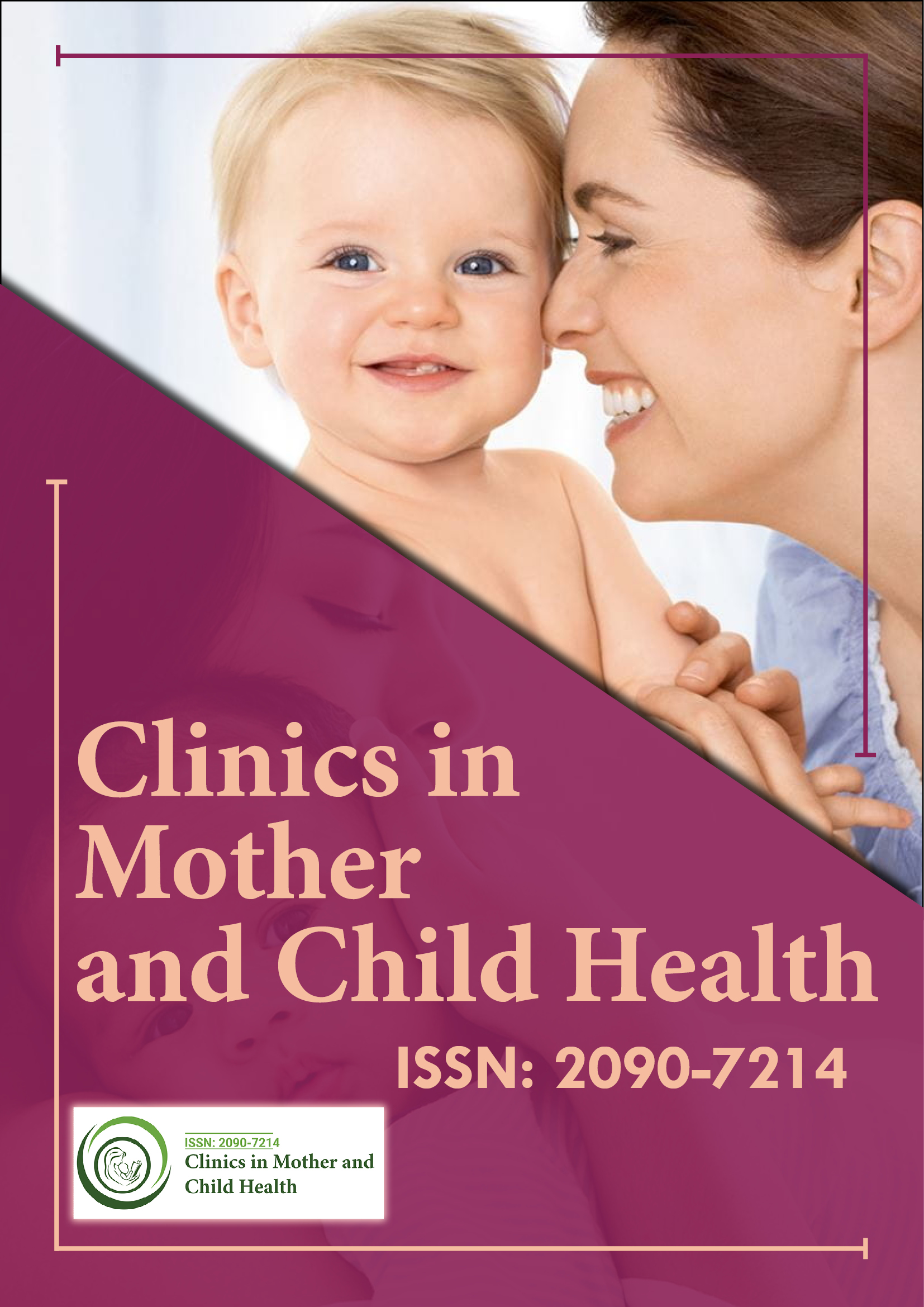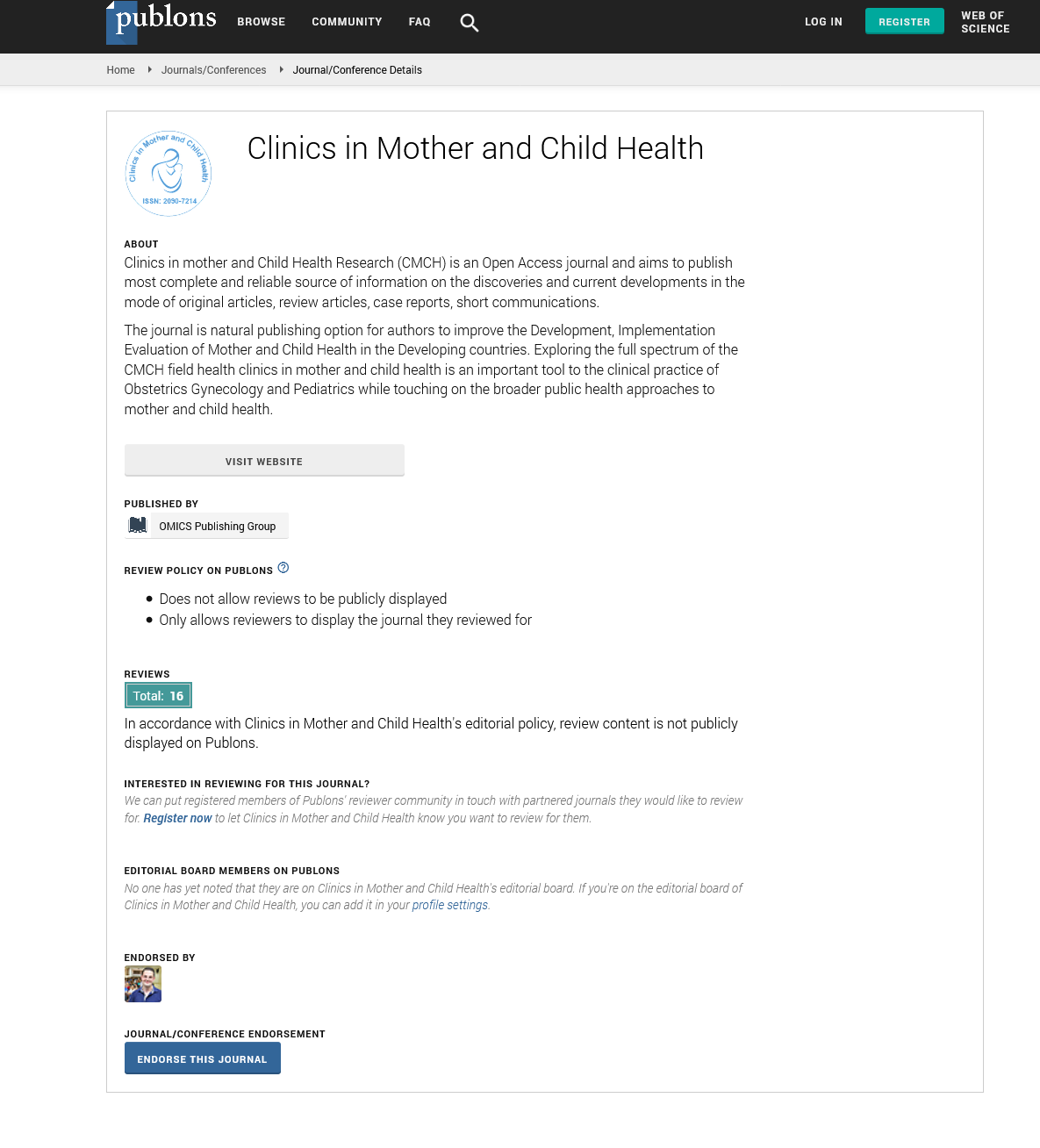Indexed In
- Genamics JournalSeek
- RefSeek
- Hamdard University
- EBSCO A-Z
- Publons
- Geneva Foundation for Medical Education and Research
- Euro Pub
- Google Scholar
Useful Links
Share This Page
Journal Flyer

Open Access Journals
- Agri and Aquaculture
- Biochemistry
- Bioinformatics & Systems Biology
- Business & Management
- Chemistry
- Clinical Sciences
- Engineering
- Food & Nutrition
- General Science
- Genetics & Molecular Biology
- Immunology & Microbiology
- Medical Sciences
- Neuroscience & Psychology
- Nursing & Health Care
- Pharmaceutical Sciences
Commentary - (2025) Volume 22, Issue 2
Association Between Prenatal Exposure to Air Pollution and Low Birth Weight: Evidence from Urban and Rural Populations
Natnita Rerkasem*Received: 27-Jan-2025, Manuscript No. CMCH-25-28680; Editor assigned: 29-Jan-2025, Pre QC No. CMCH-25-28680; Reviewed: 12-Feb-2025, QC No. CMCH-25-28680; Revised: 18-Feb-2025, Manuscript No. CMCH-25-28680; Published: 26-Feb-2025, DOI: 10.35248/2090-7214.25.22.509
Description
Low Birth Weight (LBW), defined as a birth weight of less than 2,500 grams, remains a major public health concern globally due to its association with increased neonatal morbidity, impaired infant development and long-term health risks. Growing evidence suggests that environmental exposures during pregnancy, particularly air pollution, play a significant role in influencing fetal growth and birth outcomes. This study investigates the association between prenatal exposure to ambient air pollutants and the incidence of low birth weight, focusing on populations from both urban and rural settings to provide comparative insights across different environmental and socioeconomic contexts.
The research was conducted as a population-based observational study across four regions, two urban and two rural, with varying levels of industrial activity, vehicular density and agricultural practices. A total of 3,500 mother-infant pairs were enrolled, selected from birth registries and antenatal clinic records. Eligibility criteria included singleton pregnancies with known gestational age and complete antenatal and delivery records. Data on maternal health, socioeconomic status, lifestyle behaviours and access to prenatal care were collected through structured interviews and validated medical records. Birth weight was recorded within the first hour after delivery using calibrated digital scales to ensure accuracy and uniformity across study sites.
Exposure to air pollution during pregnancy was estimated using a combination of fixed-site air quality monitoring data and geospatial modelling techniques based on the mothers' residential addresses. The primary pollutants of interest were particulate matter less than 2.5 microns in diameter (PM2.5), nitrogen dioxide (NOâ??), sulfur dioxide (SOâ??) and ozone (Oâ??). Exposure levels were calculated for each trimester to evaluate critical windows of vulnerability during fetal development. Seasonal variations, local topography and meteorological conditions were also considered in the exposure assessment models to enhance precision.
Analysis of the data revealed a significant association between higher levels of air pollution during pregnancy and an increased risk of delivering a low birth weight infant. Among mothers residing in urban areas, where average PM2.5 levels consistently exceeded World Health Organization (WHO) guidelines, the incidence of LBW was 14.2%, compared to 9.6% in rural regions. However, in rural areas with seasonal crop burning and limited air quality controls, peaks in pollutant exposure during the dry season were also correlated with elevated LBW rates, indicating that rural populations are not exempt from risk.
The strongest associations were observed with third-trimester exposure to PM2.5 and NOâ??. Infants born to mothers in the highest quartile of PM2.5 exposure during the final trimester were nearly twice as likely to be of low birth weight compared to those in the lowest quartile. The biologic plausibility of this association is supported by evidence that fine particulates and gaseous pollutants can induce systemic inflammation, oxidative stress and placental dysfunction, all of which may impair nutrient and oxygen transport to the fetus. Additionally, NOâ?? exposure was found to be significantly associated with Intra Uterine Growth Restriction (IUGR), particularly in urban settings with high traffic congestion.
Socioeconomic and maternal factors were found to modify the relationship between air pollution and LBW. Mothers with lower educational attainment, inadequate antenatal care, poor nutritional status, or pre-existing conditions such as hypertension and anemia were more susceptible to the adverse effects of air pollution. These findings underscore the compounding impact of environmental and social determinants on pregnancy outcomes. Notably, maternal smoking, household use of solid fuels and passive smoke exposure were also considered as covariates and adjusted for in multivariate analyses, further reinforcing the independent role of ambient air pollution in influencing birth weight.
The comparative analysis between urban and rural populations provided critical insights. While urban areas presented a more constant exposure to high levels of vehicular emissions and industrial pollutants, rural areas faced episodic yet intense exposure related to biomass burning and unregulated agricultural activities. This dual burden highlights the need for context-specific interventions and pollution control strategies that address both chronic and seasonal exposure sources.
This study presents robust evidence that prenatal exposure to ambient air pollution is significantly associated with increased risk of low birth weight, with consistent findings across both urban and rural populations. The results emphasize the urgent need for targeted public health policies to reduce air pollution exposure among pregnant women, especially during critical Clinics periods of fetal development. Interventions such as improving urban air quality, regulating rural burning practices and incorporating environmental health education into prenatal care services can play a vital role in mitigating these risks. As air pollution continues to rise in many low- and middle-income countries, addressing its impact on maternal and neonatal health should become a priority in the broader agenda of environmental and reproductive health equity.
Citation: Rerkasem N (2025). Association Between Prenatal Exposure to Air Pollution and Low Birth Weight: Evidence from Urban and Rural Populations. Clinics Mother Child Health. 22:509.
Copyright: © 2025 Rerkasem N. This is an open-access article distributed under the terms of the Creative Commons Attribution License, which permits unrestricted use, distribution and reproduction in any medium, provided the original author and source are credited.

